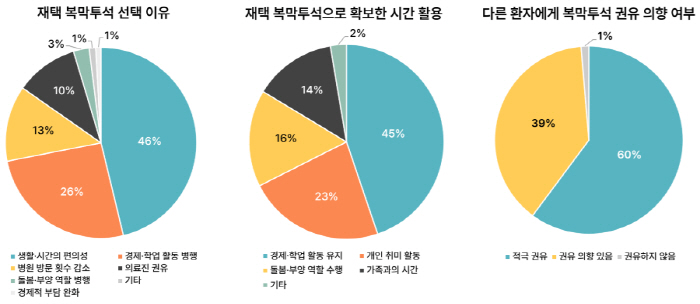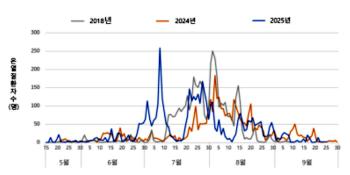95% of patients with peritoneal dialysis at home, economic activity and academic sustainability...desperate for policy support
Oct 16, 2025
The Korean Society of Kidney (Chairman Park Hyung-cheon, Yonsei University) announced the results of the 「"Effectiveness Assessment Medical Site Survey」 jointly conducted with Nam In-soon of the Democratic Party of Korea.
The survey was conducted from September 3 to 13 at 98 medical institutions nationwide on 452 patients with peritoneal dialysis, 112 doctors, and 99 nurses (a total of 663) at home. As a result of the investigation, it was confirmed that peritoneal dialysis at home increases the quality of life and treatment satisfaction of patients and has a positive effect on maintaining social and economic activities.
End-stage kidney disease patients with decreased kidney function require renal replacement therapy such as dialysis or kidney transplantation, and dialysis includes hemodialysis and home peritoneal dialysis. For peritoneal dialysis at home, patients can go through dialysis on their own at home and visit the hospital about once a month. It can be an effective alternative for patients who have to continue their social life, such as economic activities or studies, due to the higher autonomy of schedule adjustment than hemodialysis conducted through medical staff at hospitals three times a week.
As of 2024, the hemodialysis rate among patients with end-stage kidney disease in Korea was 80.2% and kidney transplantation was 16.0%, while at-home peritoneal dialysis was only 3.8%. Since 2019, the government has implemented a 'Home Management Pilot Project for Peritoneal dialysis Patients' Home Management' to support home management of peritoneal dialysis patients, and the project is set to end in December this year. This survey is meaningful in that it numerically confirmed the effectiveness of the pilot project felt by patients and medical staff at the site.
In this survey, patients cited maintenance of daily life as the biggest reason for choosing peritoneal dialysis at home. 86% of patients chose peritoneal dialysis at home to maintain daily life such as convenience of living and time, reduction in the number of hospital visits, economic and academic activities, and care and support.
In fact, patients were shown to have an average of 20 hours of additional time per week by choosing peritoneal dialysis from home. Patients responded that they were using their secured time mainly for economic and academic activities (45%), hobbies such as travel and going out (23%), and caring and supporting roles (16%).
In particular, 95% of patients said that economic and academic activities can be maintained even after peritoneal dialysis at home (78% with no impact at all, 17% with impact but maintainable). If peritoneal dialysis from home is not possible, it will disrupt economic and academic activities of up to 100 hours per month, showing that peritoneal dialysis from home is essential for the daily life of patients.
Treatment satisfaction was also high. Not a single patient responded that the quality of life deteriorated due to peritoneal dialysis at home, indicating that all patients maintained or improved their quality of life. In addition, 99% of patients said they were willing to recommend peritoneal dialysis at home to other patients (60% actively recommended and 39% willing to recommend).
Regarding the conversion of the pilot project to the main project, 94% of patients expressed their intention to continue participating in the conversion to the main project, and 97% said the conversion to the main project was necessary. However, he emphasized that it is essential to expand communication with medical staff (58%) and remote management (43%) by expanding the number of dedicated nurses when converting the main project.
Medical staff also evaluated the pilot project positively. 86% of doctors and 78% of nurses felt that the pilot project improved the quality of life, satisfaction, and willingness to continue treatment of patients with peritoneal dialysis at home, and 88% of nurses, in particular, said education and counseling have actually helped patient management.
85% of doctors agreed that the proportion of patients with peritoneal dialysis at home should increase from the current (4.5%), but the need for institutional improvement was greatly highlighted. As a major reason for the decline in the proportion of patients, 97% of doctors pointed out that there was no policy environment to recommend peritoneal dialysis. Specifically, they said that it is urgent to improve fees (95%) and expand infrastructure (73%) such as dedicated facilities and professional personnel. In order to activate peritoneal dialysis, 61% of nurses also said they needed manpower and medical support (37% support for education and counseling personnel and 24% support for remote monitoring personnel and medical personnel).
Park Hyung-cheon, Chairman of the Korean Kidney Society, said "This investigation clearly confirmed that peritoneal dialysis at home is an option that can substantially contribute to daily recovery and quality of life improvement of dialysis patients""In order to stably create a patient-centered treatment environment in which patients can choose a dialysis method suitable for their lives, policy discussions should be made as soon as possible to improve the home dialysis environment based on the results of this peritoneal dialysis home management pilot project survey.""
The detailed results of this survey can be found on the website of the Korean Kidney Association.
The survey was conducted from September 3 to 13 at 98 medical institutions nationwide on 452 patients with peritoneal dialysis, 112 doctors, and 99 nurses (a total of 663) at home. As a result of the investigation, it was confirmed that peritoneal dialysis at home increases the quality of life and treatment satisfaction of patients and has a positive effect on maintaining social and economic activities.
End-stage kidney disease patients with decreased kidney function require renal replacement therapy such as dialysis or kidney transplantation, and dialysis includes hemodialysis and home peritoneal dialysis. For peritoneal dialysis at home, patients can go through dialysis on their own at home and visit the hospital about once a month. It can be an effective alternative for patients who have to continue their social life, such as economic activities or studies, due to the higher autonomy of schedule adjustment than hemodialysis conducted through medical staff at hospitals three times a week.
As of 2024, the hemodialysis rate among patients with end-stage kidney disease in Korea was 80.2% and kidney transplantation was 16.0%, while at-home peritoneal dialysis was only 3.8%. Since 2019, the government has implemented a 'Home Management Pilot Project for Peritoneal dialysis Patients' Home Management' to support home management of peritoneal dialysis patients, and the project is set to end in December this year. This survey is meaningful in that it numerically confirmed the effectiveness of the pilot project felt by patients and medical staff at the site.
In this survey, patients cited maintenance of daily life as the biggest reason for choosing peritoneal dialysis at home. 86% of patients chose peritoneal dialysis at home to maintain daily life such as convenience of living and time, reduction in the number of hospital visits, economic and academic activities, and care and support.
In fact, patients were shown to have an average of 20 hours of additional time per week by choosing peritoneal dialysis from home. Patients responded that they were using their secured time mainly for economic and academic activities (45%), hobbies such as travel and going out (23%), and caring and supporting roles (16%).
In particular, 95% of patients said that economic and academic activities can be maintained even after peritoneal dialysis at home (78% with no impact at all, 17% with impact but maintainable). If peritoneal dialysis from home is not possible, it will disrupt economic and academic activities of up to 100 hours per month, showing that peritoneal dialysis from home is essential for the daily life of patients.
Treatment satisfaction was also high. Not a single patient responded that the quality of life deteriorated due to peritoneal dialysis at home, indicating that all patients maintained or improved their quality of life. In addition, 99% of patients said they were willing to recommend peritoneal dialysis at home to other patients (60% actively recommended and 39% willing to recommend).
Regarding the conversion of the pilot project to the main project, 94% of patients expressed their intention to continue participating in the conversion to the main project, and 97% said the conversion to the main project was necessary. However, he emphasized that it is essential to expand communication with medical staff (58%) and remote management (43%) by expanding the number of dedicated nurses when converting the main project.
Medical staff also evaluated the pilot project positively. 86% of doctors and 78% of nurses felt that the pilot project improved the quality of life, satisfaction, and willingness to continue treatment of patients with peritoneal dialysis at home, and 88% of nurses, in particular, said education and counseling have actually helped patient management.
85% of doctors agreed that the proportion of patients with peritoneal dialysis at home should increase from the current (4.5%), but the need for institutional improvement was greatly highlighted. As a major reason for the decline in the proportion of patients, 97% of doctors pointed out that there was no policy environment to recommend peritoneal dialysis. Specifically, they said that it is urgent to improve fees (95%) and expand infrastructure (73%) such as dedicated facilities and professional personnel. In order to activate peritoneal dialysis, 61% of nurses also said they needed manpower and medical support (37% support for education and counseling personnel and 24% support for remote monitoring personnel and medical personnel).
Park Hyung-cheon, Chairman of the Korean Kidney Society, said "This investigation clearly confirmed that peritoneal dialysis at home is an option that can substantially contribute to daily recovery and quality of life improvement of dialysis patients""In order to stably create a patient-centered treatment environment in which patients can choose a dialysis method suitable for their lives, policy discussions should be made as soon as possible to improve the home dialysis environment based on the results of this peritoneal dialysis home management pilot project survey.""
The detailed results of this survey can be found on the website of the Korean Kidney Association.
|
This article was translated by Naver AI translator.














